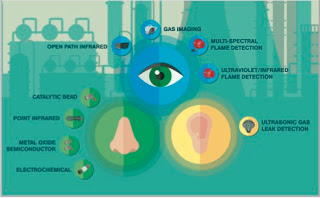 |
| Understanding the Human Sensory Model of Gas Detection (courtesy of MSA) |
Legacy sensors traditionally relied on the "sense of smell" to detect minuscule amounts of gas emanating from a leak. There's a problem with this approach though. If a leak doesn't contact the sensor, it can go undetected, leaving you unaware of a potentially critical situation. Situations whereby leaks are prevented from reaching a detector are not uncommon and are further complicated by the physical layout complexity of a room or area. Gas and vapor leaks are affected by ambient conditions, and properties such as the density of the leaking material, the surrounding ambient temperature, and nearby air flow (such as wind or breeze) all impact the detection strategy. Irrespective to the number of traditional sensors installed, these conditions jeopardize the reliability of the detection strategy.
Human Sensory Model
Given these difficulties, a recent strategy in gas and flame detection has emerged for use within industrial plants. A practice referred to as "The Human Sensory Model" presents a more reliable system for gas, vapor, and flame detection. This model uses "layers" of monitoring and detection in hazardous environments, with smell based detectors being one of the layers.
The layers of detection include several additional technologies, that together, mimic the human sensory system of smelling, seeing, and hearing. Integrated optical infrared gas sensors, along with gas imaging and optical flame detectors allow detectors to see a leak or flame, while catalytic bead detectors “sniff” for gases, and ultrasonic sensors “listen” for escaping gases. These detectors react in ways resembling those of human beings (hence the name) and use the combined intelligence of multiple inputs. Through layering sensor technology, a plant can achieve a much more reliable chain of defense against hazardous gases and flames.
Always consult an application expert before specifying or installing gas and flame detection equipment. Their expertise will help ensure a safe and reliable outcome.
For more information, contact:
Power Specialties Inc.
(800) 432-6550
https://powerspecialties.com